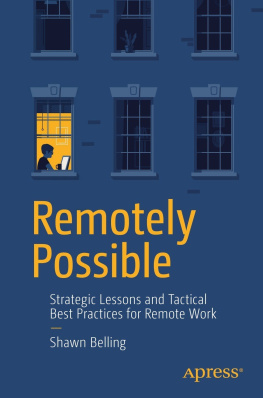VIRTUAL TEAMS AND REMOTE WORKING
How to Successfully Work Remotely and Lead Virtual Teams
Andrew James Robinson
Copyright 2020 by Andrew James Robinson
All rights reserved.
This document is geared towards providing exact and reliable information with regards to the topic and issue covered. The publication is sold with the idea that the publisher is not required to render accounting, officially permitted, or otherwise, qualified services. If advice is necessary, legal or professional, a practiced individual in the profession should be ordered.
From a Declaration of Principles which was accepted and approved equally by a Committee of the American Bar Association and a Committee of Publishers and Associations.
In no way is it legal to reproduce, duplicate, or transmit any part of this document in either electronic means or in printed format. Recording of this publication is strictly prohibited and any storage of this document is not allowed unless with written permission from the publisher. All rights reserved.
The information provided herein is stated to be truthful and consistent, in that any liability, in terms of inattention or otherwise, by any usage or abuse of any policies, processes, or directions contained within is the solitary and utter responsibility of the recipient reader. Under no circumstances will any legal responsibility or blame be held against the publisher for any reparation, damages, or monetary loss due to the information herein, either directly or indirectly.
Respective authors own all copyrights not held by the publisher.
The information herein is offered for informational purposes solely, and is universal as so. The presentation of the information is without contract or any type of guarantee assurance.
The trademarks that are used are without any consent, and the publication of the trademark is without permission or backing by the trademark owner. All trademarks and brands within this book are for clarifying purposes only and are the owned by the owners themselves, not affiliated with this document.
I NTRODUCTION
Chapter 1 The team and the teams
Defining the team
Types of teams
Advantage of implementing remote work
Chapter 2 - Working successfully in virtual teams
How to select the right people in your virtual team?
How to successfully work together?
Working remotely: how to understand and make it work
How to improve productivity when working from home
Strong keys to building a healthy and productive virtual culture
Strategies for working in virtual intercultural teams
Intercultural virtual teams and their challenges
Chapter 3 - Leading virtual teams
Motivating virtual teams
How to improve the productivity of your virtual team
Conflict management in virtual teams
From conflict to cooperation: building stronger intercultural teams
How to manage an intercultural team?
Activities that help virtual teams cohesion
Monitoring the virtual teams performance
Chapter 4 - Challenges faced by virtual teams
Chapter 5 - The main mistakes to avoid
Chapter 6 Virtual team meetings
Essential for virtual team meetings
Best practices for virtual team meetings
Common challenges for virtual team meetings
CONCLUSIONS
Useful resources
T he concept of virtual or remote teams is not a new phenomenon. However, technological updates, globalization, organizational structures and ways of working, and, recently, the pandemic, have meant that approach has grown significantly. People now have many more opportunities of working from home, from the car, in alternative places or even on the other part of the world, which means managers may rarely see them.
As a result, managers who are called to lead these virtual teams not only have to face the usual leadership dilemmas, but they must be able to adapt to these challenges in an environment in which the rules have totally changed.
The question is: is it really possible to manage, effectively and productively, a team of people distributed all over the world? Can you really make business with virtual teams? These are just some of the most frequently asked questions that are asked by managers or entrepreneurs who decide to start a business, not only in the United States. The answer is obviously YES.
We need to change the point of view and focus on flexibility and communication (important in a traditional office and indispensable in an online one) to create a team capable of collaborating, achieving objectives and doing business. Distance should not be considered a limit, on the contrary.
It was almost 15 years ago when I was assigned as manager of a team of almost 100 people from three continents: Europe (several countries like Italy, France, United Kingdom, Spain, Romania, Poland), America (USA) and Asia (China). The company I was working for was implementing a huge reorganization project and, according to the new organization chart, many support functions have been outsourced to some service centers in Poland and Romania and large part of the manufacturing was moved to China. It was a challenging moment for the company and for my career. I remember our CEO saying it will not be the last move for our company in this direction of a globalization and cost efficiency strategy and we were called to show flexibility and openness. And he was right.
But what flexibility meant to him was probably different to what, the same concept, meant to me or to other member teams. It was not the first time me and my co-workers were called to work together and collaborate with teams from another country, continent, entity. But this time was different; those teams were like one big team, only located in different locations.
The journey was full of challenges and satisfactions, funny moments but also frustrations and anxieties. It was part of the process, and what I can say now is that the crucial factor that helped us exist, and excel, was a good communication and tools to support such a virtual reality.
I left the team after 8 years and, all I know now, is that after that experience, I only choose to be part of a virtual team, and I am keep doing it now, as a freelancer consultant and author. That experience had a huge impact on my professional career.
I want to share with you my perspective, from an operational point of view, about this reality that is becoming to be, from the only option, the favorite working option for many companies. Few years ago, Upwork, the largest freelancing website, released the results of its Future Workforce Report and the results said it clear: 63% of the companies had remote workers and were familiar on daily basis with the virtual teams. Today, with this pandemic situation, this percentage drastically increased; at that point that many companies, including Twiter, announced employees will be allowed to work from home forever.
Next page










